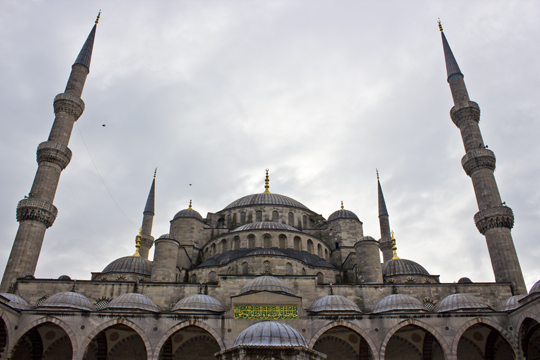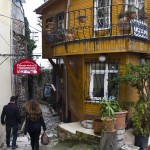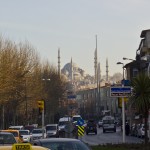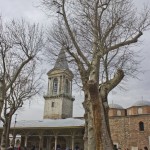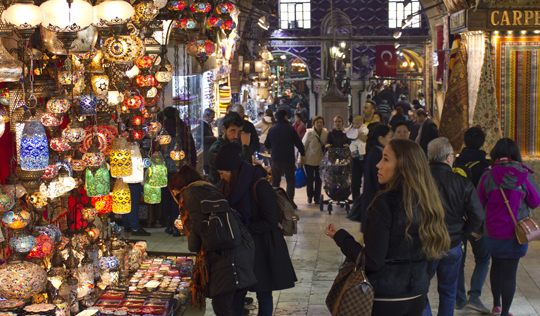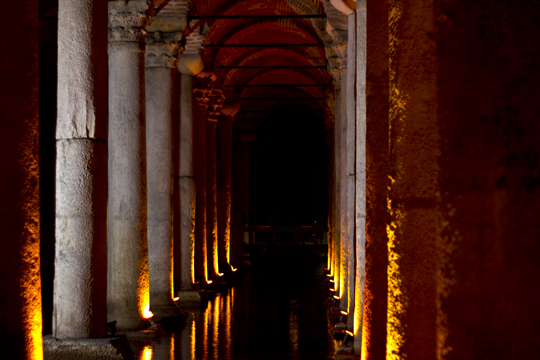I always had an immense curiosity about Istanbul, mainly because as capital of the Eastern Empire, or Byzantine Empire, it was one of the most important cities in the world, alongside Rome. As you already know I’m fascinated by History, therefore this kind of city always gets my interest.
Besides, who doesn’t want to have their feet in Europe with their eyes over Asia? Istanbul is the only city in the world located in two continents!
Well, Istanbul greatly overcame my expectations; the city is magical, completely frantic, mystical, mysterious and able to seduce us in the most varied aspects.
It has a population of more than 15 million, the majority being Muslim. But that’s not something to be afraid of, the recent events may lead to fewer people visiting Istanbul, but please don’t miss the opportunity, moreover, I must confess I felt cherished, safe as in any other capital, and I can assure you I feared much more while visiting other regions inhabited by more Orthodox Muslims in Paris or Brussels than this time in Istanbul!
Istanbul is the biggest city in Turkey, and the fifth in the world, as well as one of the most populated in Europe, but contrary to what many may think, it’s not the capital, at least since 1923, when that title went to Ankara. However, Istanbul keeps the main focus in terms of industry, business and religion.
History
Although in 2008, during some construction works, being discovered historical findings that can put Istanbul dating from 6500 B.C., it is taken as valid that the city was founded in the VII century B.C.
Firstly with the name of Byzantium, given by the King of Megarean, Byzas, who discovered these amazing lands consulting the Oracle of Delphi. Legend or not, some truth it must have.
Due to its idyllic location, Istanbul was always highly coveted, and although its development was slow at first, after Christ things accelerated a bit!
Therefore, in 196 A.D., the city was under the domain of Emperor Septimus Severus who ordered its destruction, but years later ordered its reconstruction. In charge of this Emperor is one of the most historical places in town, the Hippodrome of Constantinople.
A few years later, in 330 A.D., one of the most self-centered Emperors in history was reigning – Constantine the Great, who baptized the city as Constantinople!
Already in power, he was responsible by the implementation of Christianity, ordering the construction of the monumental Hagia Sophia during that time.
In 395 A.D. with the division of the Roman Empire, with Rome being the Western Empire and Constantinople the Byzantine Empire, the city was finally prospering, increasing area and significance. So, while Constantinople grew, Rome was losing strength, and in 476 A.D., Rome fell, and that was the defining moment to the climax of the Byzantine Empire, namely during the reign of Justinian the Great, from 527 to 565.
In the following centuries the Empire declined, but already during the IX and X centuries it went back to prospering. The downside is that when a place is prospering there’s always someone wanting to occupy it! And so it was during the Fourth Crusade, when it was dominated by the Latin Empire.
Meanwhile came the time of the Ottoman Empire, the Sultans dominated from the XV century and the city grew immensely, establishing another Era – Istanbul ruled by the Turkish!
As you can see, Istanbul is filled with centuries of a fascinating history!
Nowadays, it is a vibrant and magical city, which borders with several countries, like Syria, Iran, Iraq, Armenia, Azerbaijan, Georgia, Bulgaria and Greece. Maybe so it raises so much interest and also concern, at the same time.
The city is very easy to visit, even because it is divided, which allows the tourist to organize in a way to visit things in a logical order.
We were in Istanbul for five complete days, plus two for the trip.
We did Porto – Frankfurt – Istanbul with Lufthansa, which unfortunately makes us spend almost two days travelling. We arrived to the European side of the city, in the Ataturk Airport. (Fortunately, the Turkish Airlines is now making direct flights between Porto and Istanbul).
But our five days in the city were perfectly enough, of course the more time we have the more time we enjoy, but I can say five days are enough.
Therefore, let’s divide the city into areas, so you can understand the easiest way to organize yourselves.
As I said before, Istanbul is the meeting point between the East and the West, being that the Bosphorus Strait, which connects the Black Sea to the Marmara Sea, which on its turn is connected to the Mediterranean, is responsible for the separation between the European side and the Asian side. To cross it there are two big bridges, the Bosphorus Bridge and the Mehmet the Conqueror Bridge.
The Asian side is the most populated one, but the least visited, once it is majorly residential. On its turn, the European side is the mandatory visit side because it is where the centuries of history are concentrated, as well as the frantic energy of the city. So, this is divided in two parts by the Golden Horn or Haliç; and the main connection between the two parts is made by the Galata Bridge.
On the south side of the Golden Horn we have what we can call the “Old Istanbul”, the historical center, with the historical regions of Sultanahmet, Seraglio Point and Bazaar Quarter.
In this place it is still possible to observe part of the wall that used to surround the city, and protect it. Here is located the Hippodrome, the Hagia Sophia, the Blue Mosque, the Topkapi Palace, the Cisterns, the Grand Bazaar, the Spices Bazaar and several museums and mosques.
On the other side of the Galata Bridge, North of the Golden Horn, we find the modern area of Istanbul, with the Beyogli neighborhood and its busy Taskim area, and its wonderful Istiklâl Caddesi Avenue, several plazas, street commerce, the mythic Galata Tower, the imposing Dolmabahçe Palace, the different museums and the fun area of Besiktas.
So, it’s much easier to answer the question: What to visit?
Let’s start by the Old Istanbul, south of the Golden Horn.
Fortunately, the day we decided to visit this historical region of Istanbul, we had the support of Hakan, a professional guide of Luxury Istanbul, a company specialized in luxury tourism in the city that organizes from personalized guided visits to yacht trips in the Bosphorus.
After our quite well prepared arrival by Ugur Ilgar (the company owner), we were received by Hakan and the driver at our hotel, at the scheduled time, after some questions Hakan sketched the best visit plan for our personal tastes. I love to discover a city with an exclusive guide, without groups or queues, with the routes made with basis in my tastes and by someone who really knows the city well.
Hippodrome of Constantinople
This open sky place was one of the most important architectural works of Emperor Septimus Severus and was significantly improved during the Constantine Empire. This place had capacity for 100 000 people and was the focal and social point of the city. Here was the place where thousands of people reunited for the most varied moments. Unfortunately it was destroyed during the battles of the Fourth Crusade. Yet, still, is possible to imagine the craziness from other centuries, the tumult crowds during the chariot races (chariots pulled by two or four horses).
Looking around what is nowadays a beautiful square, we can observe some history marks, like the different obelisks brought by the different Emperors, true history marks that take us on an authentic trip to the past.
Hagia Shophia (Ayasofya)
This is one of the most famous and fascinating places in Istanbul, it once was a church, then a mosque and nowadays a museum.
During a long time it was the biggest architectural accomplishment in the world, being surpassed by the Seville Cathedral almost a thousand years later.
The immense building was constructed on top of two other churches and opened in 537 during the Justinian Empire.
This amazing work of art is formed by a central nave and two laterals, and it has an imposing dome with almost 60 meters of height.
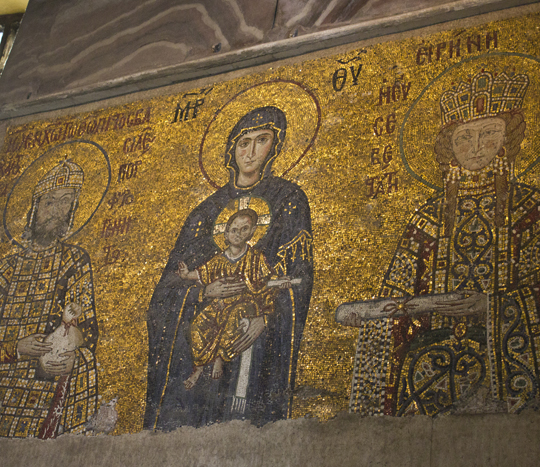
Later, in the XV century, under the Ottoman Empire, the Sultan Mehmed II ordered that the building turned into a mosque. During that time some changes were made, like the four minarets and the enormous round plates with Arabic calligraphy. The biblical images were covered and only recovered when the basilica was turned into a museum, in 1931.
Its interior is impressive, and seeing Christian images rivaling with Islamic structures is amazing!
Entrance: 30Lt
Basilica’s Cistern ( Yerebatan Sarayı )
It is one of the most curious and interesting visits in the city, because of its mystic and surrounding environment, and it is also not common.
The cisterns worked as storage and had the function to supply the city with water. This construction was made during the Byzantine Empire, in 532 and used until the fall of Constantinople.
336 Roman columns make part of that which is a magnificent mid-light show in orange tones and water reflexes.
The two most interesting columns have heads of Medusa, one of them turned down and the other bent, and what are Medusa’s heads doing here? Nobody knows!
Entrance: 20Lt
 Blue Mosque seen from Hagia Sophia
Blue Mosque seen from Hagia Sophia
Blue Mosque
This imposing work of art was ordered to be built in 1609 by Sultan Ahmed I and its beauty is immense, being one of the main visiting cards of the city. Several duomos cascade down from an immense central Duomo. This mosque has a particularity that makes it unique, it has six minarets. At the time that was a great issue, once the only one with that amount of minarets was the one in Mecca and no other could be equal. So, the Sultan Ahmet I financed the construction of seventh minaret of Mecca’s mosque!

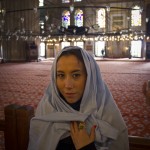

Its interior is beautiful and monumental, the walls have thousands of mosaics and stained glass in blue tones, therefore the name of the mosque.
To enter this mosque and in any other there are some respect rules, like taking off your shoes and covering your head.
Another interesting thing for me were the 5 calls made during the day for prayer. This singing is named Muezim and is chanted in the speakers of the minarets and has the function of alerting the Muslim people of the prayer time. I was already getting used to that sound during the day as I walked in the city. During these periods you can’t enter the mosque.
Entrance: free
Topkapi Palace
It was built by Mehmed II right after the conquering of Constantinople in 1453 and was the residency of Sultans for three centuries.
Nowadays the Palace is divided in several exhibition rooms with gold objects, thrones, tea-cups, cutlery, cribs, diverse jewelry and precious stones; it also has exhibitions of silverware, ceramics, miniatures, clothes, sacred Muslim relics, like for example, beard hair and the foot print of prophet Muhammad! At least they say so! Five kilometers of walls and towers protect the land of the palace. The imposing environment allows us to travel through time.

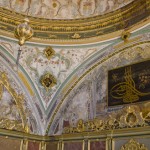
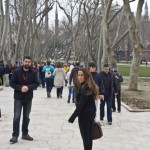
This is a visit that requires some time, so do it calmly. You can visit the different exhibitions I referred, and also the Harem (different ticket, you can buy the two at the same time, for the palace and for the Harem).
When entering, circulate through the wonderful patios and leave no detail aside.
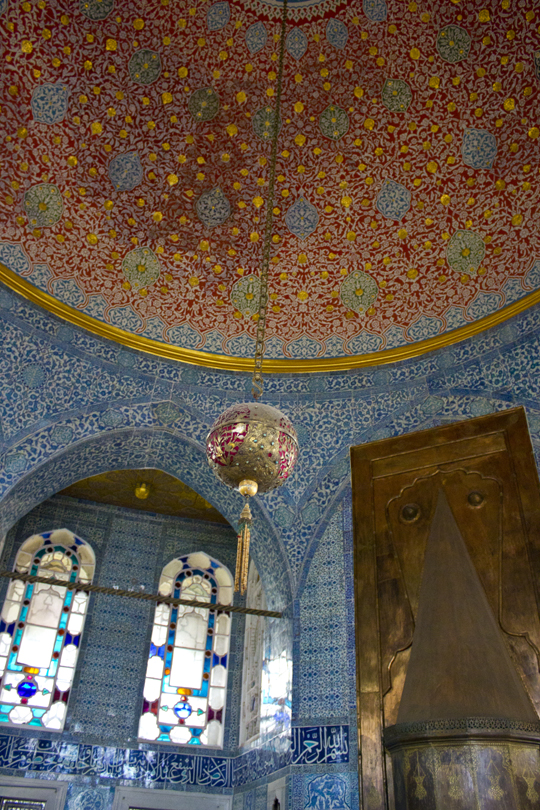
The Harem used to lodge thousands of women and concubines during the XVII century. Our imagination quickly wonders what it would be like living in that forbidden environment, only the Sultan and his sons could access the Harem. You can imagine those Arabian Nights parties, with music, dance, incense and opium…
Another interesting place in the palace are the kitchens, which demonstrate quite well the Ottoman traditions and gastronomical culture, here were daily cooked thousands of meals.
Entrance: 30Lt to the Palace + 15Lt to the Harem
One of the great advantages of visiting these buildings with a Guide was not only the great learning about history and behaviors but also the fact of not having lines to buy the tickets!
Grand Bazaar
The Grand Bazaar is probably the biggest and one of the oldest covered markets in the world. Opened in 1461, under the order of Sultan Mehmet, it is greatly known by its jewelry, ceramics, spices and tapestry (and perfect replicas, of course!). The market has four entrance gates and over 60 streets with thousands of stores.
It was firstly built as a small storage and after that to waken up the commerce in town, and to assure profits to the recently altered Hagia Sophia, that was being turned into a Mosque at the time.

For me, this was one of the places I enjoyed most in the city; the craziness and the art of negotiating are brilliant among the Turkish people! The way they approach you can be inconvenient and annoying sometimes, it is also hilarious. Their fakes are the best, I didn’t buy anything, but I was tempted!
If you chose to buy, negotiate and chaffer a lot! For what Hakan told us, our guide, if the article has a price tag it is not worthy to negotiate, if it hasn’t, you can negotiate up to 40% discount!
Be aware that the market is closed on Sundays.
 Çikita, nr. 18 of the Spices Market
Çikita, nr. 18 of the Spices Market
Spices Market (Misir Çarsisi)
If you can’t miss the Grand Bazaar in Istanbul, the Spices Market does not fall behind, particularly when you travel with João!
As soon as we entered this wonderful store complex, the perfumes invaded our smell and forwarded us into a new world of colors, aromas and flavors.
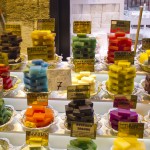


We looked around and saw pepper, saffron, cinnamon, ginger, oregano, curry, fresh, crystalized and dried fruits, as dates, figs, pistachios, apricots, pineapples, bananas, oranges, pomegranate (the madness of the Turkish!) and incredibly delicious sweets, the traditional Baklavas and Turkish delights of which I’m an assumed fan!
The spices bazaar is also an authentic eastern medicine pharmacy with traditional medicine and millenarian recipes of miracle mixes made from roots.
Basically there are spices from all the Middle East and India, and the list seems endless.
In case you want to shop at the Bazaar we recommend the store nr 18, Çikita, specialized in saffron, caviar and spices, it is more expensive than most of the stores at the Bazaar, but the quality is also notoriously different. Thanks again to another great tip from Hakan, which ended here his visit after a long day, with lots of talking and history in it. It was an excellent experience, so I must truly recommend Luxury Istanbul for this kind of service.
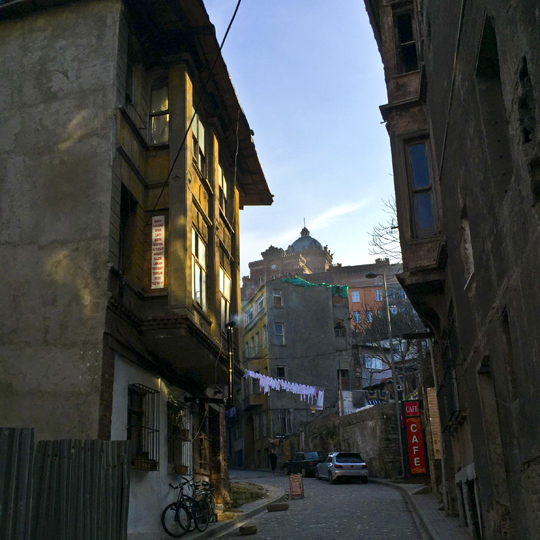 Fener and Balat with the Fener Greek Lyceum as background
Fener and Balat with the Fener Greek Lyceum as background
A littler farther away from the center, we also have places of extreme significance, like:
The Church of the Holy Savior in Chora (Kariye Mosque or Kariye Museum)
This beautiful church is considered one of the most beautiful examples of a Byzantine church.
It dates from the XI century and its interior is covered with mosaics and frescoes, many of them put there between 1315 and 1321, belonging to the powerful governor Theodorus Metochites, these show the brilliant examples of the Renaissance.
Already in the XVI century the church was turned into a mosque by the Ottoman Empire and later in a museum, in 1958.
Still far from the center, but still in the Old Istanbul I advise you to walk around the historic neighborhoods of Fener and Balat, very close to one another and where we walked after our historical lunch at Asitane, an Ottoman restaurant next to the church of Chora.
The first one was the area of residence of the upper Greek class, with houses that still have beautiful facades from other times, besides the several fires and earthquakes the city suffered. Nowadays is one of the poorest neighborhoods in the city.
The second was the residence of Jews, Greeks and Iberian that greatly contributed for the development of the city in terms of medicine and horology. And, like Fener, Balat is also one of the poorest neighborhoods in Istanbul.
Along these neighborhoods you’ll find amazing artisanal bakeries.
These are some of the places we fell in love with in Istanbul! In this antique and historical part of Istanbul there’s always more, another mosque, another museum, another store, another market, discover the city, explore it, enjoy it, Istanbul deserves to be lived and consumed in full!
Seen the first part of the Old Istanbul, south to the Golden Horn, “travel” with me to the Modern Istanbul, to north of the Golden Horn.
Istanbul (Beyoglu – Modern Istanbul)
Disclamer
– In case you need private transportation we recommend using Blacklane, which transported us during our days in Istanbul.
– We also want to thank the entire team of Luxury Istanbul for the excellent way they made our visit. On their plans, a guided visit costs approximately 115€ a day for person (price for a couple). A cruise on the Bosphorus costs approximately 250€ an hour for groups up to 12 passengers.
Where to Stay
Grand Hyatt Istanbul
Hyatt Regency Istanbul Atakoy
Ciragan Palace Kempinski
